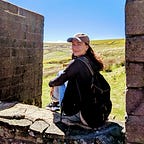How to Write Description That Actually Brings Your Scene To Life
Rule #1 — don’t marry the fly
I’m one of the lucky ones who write for a living. That means I’m also learning how to write every single day.
Recently, I signed up for a free trial on Skillshare. The very first class I took was led by author Kathy Fish, all about how to craft vivid, descriptive scenes.
For me, description is the most delicious part of writing. It’s a welcome interruption from wrangling with dialogue and plot, and it brings the characters and setting to life for your readers (and for you).
But writing vivid, creative descriptions that aren’t cheesy, tedious, or cliched — that’s tough.
I learned a lot from this class on Skillshare. It’s succinct and well-paced, and there are plenty of creative tasks throughout.
Here are just some great insights I learned from Kathy Fish. I think you’ll enjoy them, too.
- Don’t marry the fly.
Let’s say you’re writing a scene in a restaurant. A tense conversation is taking place between a couple. You decide to add in some description to make it more immersive.
Somewhere along the way, you become obsessed with a fly on the table. You describe its wings, its Latin name, its hopes, and dreams. The sound it makes as it preens itself. What the world looks like through its myriad mirrored eyes.
Suddenly, you’ve lost the reader. They’ve got no idea what’s happening anymore because you’ve wedded yourself to this random fly.
The concept of ‘marrying the fly’ comes from author Natalie Goldberg. As she puts it:
“A responsibility of literature is to make people awake, present, alive. If the writer wanders, the reader too will wander”
“Don’t become self-absorbed, which eventually creates vague, muddy writing… Recognize the fly, even love it if you want, but don’t marry it.”
2) Don’t starve your reader of description
Everyone loves a page-turner. But if your writing is line after line after line of dialogue and action, your reader will be left hungry for something else. Kathy Fish calls this kind of writing a ‘descriptive desert’.
Give them a morsel, a crumb of creative description. Your reader needs to smell, feel, and see the setting as much as they need to hear your character’s words.
3) Avoid cliches and overused phrases
As Kathy Fish puts it, ‘your reader has an imagination’.
If you say the words ‘hospital room’ — they’re already right there, among the beeping machines and antiseptic smells. You don’t need to add those tired details.
Instead, sneak a surprising detail in there that will pique your readers’ interest and put them in your hospital room with your character.
Ditch any cliched phrases, too. We’re talking ‘golden sunset’, ‘gossamer-thin thread’, ‘frail old man with papery skin’.
Here’s a trick that helps me. If two words seem to go hand in hand with each other, or sort of naturally form on the page, you’ve got a cliche on your hands.
Can you rewrite it in an unexpected way? Instead of ‘papery skin’, the old man’s hands could be ‘translucent and stretched, like the dusty cobwebs you only seem to find in barns.’
Cliches put your reader to sleep. Unexpected descriptions are a bit like winding down the car window on a long journey. A refreshing little pick-me-up.
How to write beautiful, evocative descriptions
- Immerse your reader
Give them a felt experience, using all five senses. Neglected senses, like scent, taste, and sound are particularly striking. If you want to see this done beautifully, I really recommend reading ‘Perfume: The Story of a Murderer’, by Patrick Süskind.
2. Show — don’t tell
Can you hint at the internal feeling of the characters, without spelling it out? Instead of telling us ‘Jorge is sad’, describe how his shoulders slumped so low they almost touched his knees.
3. Engage the readers’ curiosity.
Sprinkle in some unusual, surprising details — a particularly revealing book on the nightstand, a click of the tongue as the character speaks. But whatever you do, don’t marry the fly.
